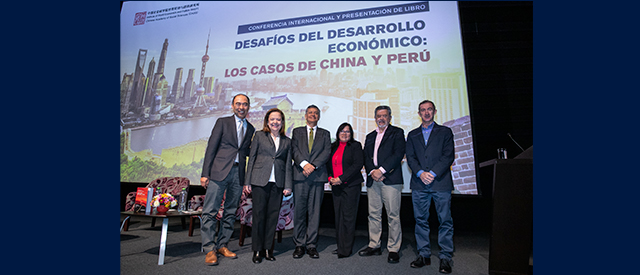International Conference and Book Launch — Economic Development Challenges: The Cases of China and Peru

On September 26, the Center for China and Asia-Pacific Studies and the Institute of World Economics and Politics (IWEP) at the Chinese Academy of Social Sciences (CASS) co-hosted an international conference and book launch entitled “Economic Development: the Cases of China and Peru” as part of the Center’s 10th anniversary celebrations.
The special guests at the event were Zhang Yuyan, director of IWEP-CASS, and Adrián Armas, central manager of economic studies at the Central Reserve Bank of Peru (BCRP) . It also features the presentation of En Búsqueda de un Camino para Evitar la Trampa del Ingreso Medio: los Casos de China y Perú by Dr. Rosario Santa Gadea, director of the Center as well as co-editor and co-author of the book, alongside a group of specialists from Universidad del Pacífico.
The event began with words of welcome from Joanna Kámiche, director of the Research Center at Universidad del Pacífico, followed by the opening speech by the ambassador of the People’s Republic of China in Peru, Song Yang.
The panel of commentators included Roberto Urrunaga, general director of the Graduate School and principal professor in the Academic Department of Economics; Gustavo Yamada, principal professor in the Academic Department of Economics; María Amparo Cruz Saco, research affiliate at the Universidad el Pacífico Research Center; and Alejandro Flores, principal professor in the Academic Department of Administration.
The IWEP-CASS director, Zhang Yuyan, explained, from different thematic perspectives, China’s current macroeconomic situation, and also highlighted the effectiveness of the economic policies that the country is implementing to boost economic growth, exports, and employment.
For his part, Adrián Armas addressed how the close economic relationship between China and Peru has manifested itself over the past 20 years through transmission mechanisms such as the demand for commodities and foreign direct investment. In this vein, he concluded that Peru’s structural reforms of the nineties allowed the country to capitalize on China’s growth and achieve above-average growth rates for the region.
Finally, the director of our center, Dr. Rosario Santa Gadea, presented the Spanish-language version of her book En Búsqueda de un Camino para Evitar la Trampa del Ingreso Medio: los Casos de China y Perú, in which she and her co-authors offer a comparative approach to the cases of economic development in China and Peru. During her presentation, Dr. Santa Gadea explained the challenges that both countries must face in order to join the ranks of high-income economies.













































